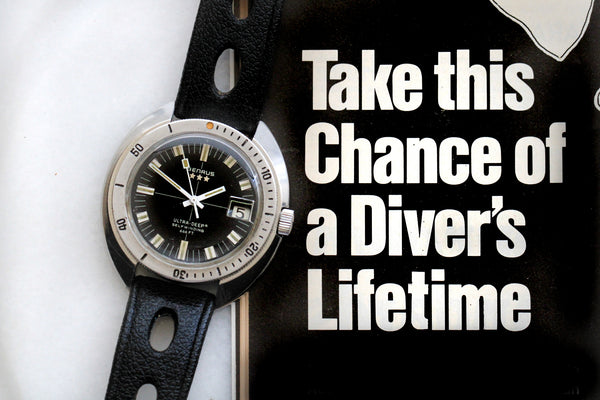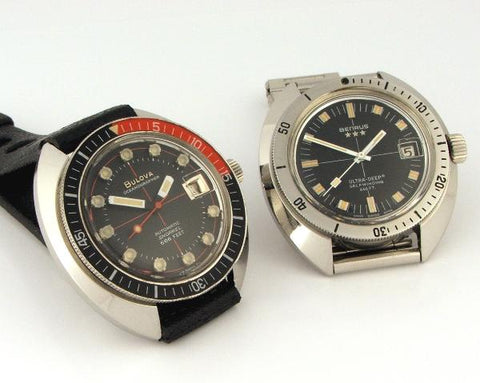
Exploring How Watches Are Lost To Time With The Benrus Ultra-Deep Skin Diver
By James Mulvale
These days vintage watches are obviously incredibly popular collector’s items. Hell, this entire website is a testament to that fact. Whilst in some ways it might seem somewhat strange to think that an average middle-of-the-road watch from fifty years ago could be sought after piece, it’s even more strange to think about how little information remains on some of these models.
.
Take this Benrus Ultra-Deep Skin Diver for example. Most fans of vintage watches might be familiar with the Benrus Ultra-Deep super compressor, but it’s unlikely that they’ll have seen this cushion-cased dive watch before.
.
Which is rather unusual when you think about it. For starters, Benrus was a large company. It was founded in 1921 by Benjamin Lazarus and his two brothers, and over the next few decades, it would grow to become one of the biggest watch manufacturers in America. Benrus became known for the watches they supplied to the U.S. military, as well as one of their watches being worn by actor Steve McQueen in the 1968 action thriller, 'Bullitt.'

Steve McQueen wearing his ref.3061. photo credit Oracle Time.
.
However, like so many other brands Benrus’s success was not to last, and the Quartz Crisis of the 1970s gravely affected the company's sales. This led to the company filing for bankruptcy in 1977. It wasn’t until 2020 that the company was reborn, under new owners who had acquired the rights to the brand.
.
Given the size of Benrus, it’s probable that any given model in their catalogue would have been produced in fairly significant numbers. So how did virtually all the information about this Benrus Skin Diver disappear? Well, the previously mentioned Quartz Crisis is sure to have had a big hand in it. With the dissolving of the original Benrus company most, if not all, of the company's original records would have been lost or destroyed, as they were no longer needed.
.
The other source of information on a specific model is marketing material, which remains almost as elusive as the company records. The reason for this being that the marketing material like adverts and shop displays simply weren’t designed to be stored. Fortunately, a few documents remain, but this is more by chance than anything else. Old magazines can often be a good source of period advertisements, and the odd Benrus ad that survives provides a rare insight into the companies pricing and branding in the period.

.
It’s also important to consider how these watches were made. Unlike today where large brands will have the vast majority of parts produced especially for a specific model, that wasn’t the case in the Sixties. Back then brands would often procure existing parts from manufacturers of particular elements like hands or cases, and use them to assemble new watches. It’s one of the reasons you’ll often find two watches that are completely identical apart from the name on the dial.
.
As a result of this practice, we could assume that this Ultra-Deep Skin Diver was made in relatively small quantities, using existing parts. Some evidence to support this is that the watch actually has the same case as the famous Bulova Oceanographer Devil Diver.

The Bulova Oceangrapher and The Benrus Ultra Deep Side by Side. Credit Scuba Watch
.
Digging around for more information on the watch, I also found out that it’s also nearly identical to another Benrus model called the Citation. In fact, whilst there are several versions of the Citation, this Ultra-Deep is identical to one Citation model with the exception of the dial text.

The Benrus Citation. Credit Gear Patrol
.
Given that this Ultra-Deep is generally considered to be from the late 1960s, and that the Citation dates from the late 1960s to 1970s, I’m inclined to think that this Ultra-Deep is a precursor to the later model.
.
It’s not unreasonable to assume that Benrus introduced this version of the Ultra-Deep to fill their catalogue, and chose to make use of one of their existing trademarks, before going on to create the Citation collection at a later date.
.
Of course, this is all guesswork, but whatever the truth, it doesn’t change the fact that this Ultra-Deep is still a really nice example of a classic skin diver watch from the late 1960s. It’s got a number of features that both indicate its quality and make it a great choice for anyone looking to add a vintage watch to their collection.
.
Firstly, the case is produced from solid stainless steel, and not the cheaper chrome-plated brass used on cheaper watches of the period. It also measures a thoroughly modern 41mm across, with is rather large for a watch from the 1960s, but perfect for modern tastes.
.
This Ultra-Deep also retains its original acrylic crystal too, complete with an internal date magnifier. This is an interesting feature that’s rarely seen, but which in many ways is better than the alternative external magnifier that provides an unsightly bulge on the surface of the crystal.
.
For the movement, the watch uses a reliable ETA 2472 automatic calibre. This was a common calibre at the time, and ETA are still known today as one of the best manufacturers of reliable Swiss movements.
.
Lastly, the watch has its classic period design going for it. As a product of the late Sixties, this Benrus Ultra-Deep has a clean, legible dial layout that provides the no-nonsense functionality you want in a dive watch.
.
In some ways, this watch could be considered a bit of a time capsule from another era. It gives us a tiny glimpse into the past, and whilst we’ll never know its full story, somehow that only adds to its mystique.
.

Shop Benrus Ultra Deep 666ft Skin Divers Wristwatch Ref.6502
HERE
HERE
